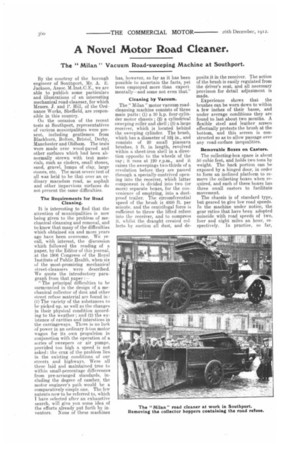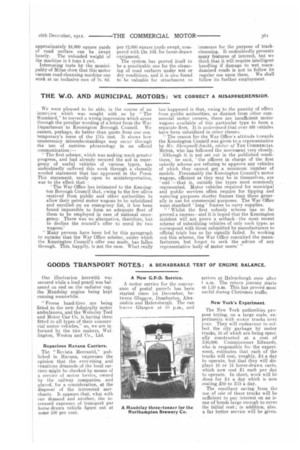A Novel Motor Road Cleaner.
Page 4

Page 5

If you've noticed an error in this article please click here to report it so we can fix it.
The " Milan " Vacuum Road-sweeping Machine at Southport.
By the courtesy of the borough engineer of Southport, Mr. A. E. Jackson, Assoc. M.Inst.C.E., we are able to publish some particulars and illustrations of an interesting mechanical road-cleanser, for which Messrs. J. and P. Hill, of the Ordnance Works, Sheffield, are responsible in this country.
On the occasion of the recent tests at Southport, representatives of various municipalities were present, including gentlemen from Blackburn, Bolton, Bristol, Derby, Manchester and Oldham. The tests were made over wood-paved and other surfaces which had been abnormally strewn with test materials, such as cinders, small stones, sand, gravel, lumps of clay, large stones, etc. The most severe test of all was held to be that over an ordinary macadam road, as asphalt and other impervious surfaces do not present the same difficulties.
The Requirements for Road Cleaning.
It is interesting to find that the attention of municipalities is now being given to the problem of mechanical cleansing and removal, and to know that many of the difficulties which obtained six and more years ago have been overcome. We recall, with interest, the discussion which followed the reading of a paper, by the Editor of this journal, at the 1900 Congress of the Royal Institute of Public Health, when six of the most-promising mechanical street-cleansers were described. We quote the introductory paragraph from that paper :—
" The principal difficulties to be surmounted in the design of a mechanical collector of dust and other street refuse material are found in : (I) The variety of the substances to be picked up, as well as the changes in their physical condition according to the weather ; and (2) the existence of cavities and interstices in the carriageways. There is no lack of power in an ordinary 5-ton motor wagon for its own propulsion in conjunction with the operation of a series of sweepers or air pumps, provided too high a speed is not asked : the crux of the problem lies in the existing conditions of our streets and highways. Were all these laid and maintained true to within small-percentage differences from pre-arranged standards, including the degree of camber, the motor engineer's path would be a comparatively simple one. The few patents now to be referred to, which I have selected after an exhaustive search, will give you some idea of the efforts already put forth by inventors. None of these machines
has, however, so far as it has been possible to ascertain the facts, yet been employed more than experimentally—and some not even that," Cleaning by Vacuum.
The " Milan " motor vacuum roadcleansing machine consists of three main parts : (1) a 30 h,p. four-cylinder motor chassis ; (2) a cylindrical sweeping roller and shell ; (3) a large receiver, which is located behind the sweeping cylinder. The brush, which has a diameter of 52i in., and consists of 20 small piassava brushes, 5 ft. in length, revolved within a sheet-iron shell in a direction opposite to the wheels of the car ; it runs at 120 r.p.m., and it raises the sweepings two-thirds of a revolution before they are passed through a, specially-contrived opening into the receiver, which latter component is divided into two (or more) separate boxes, for the convenience of emptying, into a dustproof trailer. The circumferential speed of the brush is 4950 ft. per minute. and the centrifugal force is sufficient to throw the lifted refuse into the receiver, and to compress it, whilst, the draught created collects by suction all dust, and de
posits it in the receiver. The action of the brush is easily regulated from the driver's seat, and all necessary provision for detail adjustment is made.
Experience shows that the brushes can be worn down to within a. few inches of their bases, and under average conditions they are found to last about two months. A flexible steel and leather screen effectually protects the brush at the bottom, and this screen is constructed so as to allow passage over any road-surface inequalities.
Removable Boxes on Castors.
The collecting-box space is about 50 cubic feet, and holds two tons by weight. The back portion can he exposed by a hinged door, in order to form an inclined platform to remove the collecting boxes when required, and each of these boxes has three small castors to facilitate movement.
The chassis is of standard type, but geared to give low road speeds. In the machine under notice, the gear ratios that have been adopted coincide with road speeds of two, four and eight miles an hour, respectively. In practice, so far, approximately 24,000 square yards of road surface can be swept hourly. The unloaded weight of the machine is 3 tons 5 cwt.
Interesting tests by the municipality of Milan show that this motor vacuum road-cleansing machine can work at an inclusive cost of 7s. 8d. per 12,000 square yards swept, compared with 13e. 10d. for horse-drawn equipment.
The system has proved itself to be a practicable one for the cleansing of road surfaces under wet or dry conditions, and it is also found to be valuable for attachment to tramcars foi. the purpose of trackcleansing. It undoubtedly presents many features of interest, but we think that it will require intelligent handling if damage to wet macadamized roads is not to follow its regular use upon them. We shall follow its further employment.




















